Food macromolecules Study guides, Class notes & Summaries
Looking for the best study guides, study notes and summaries about Food macromolecules? On this page you'll find 880 study documents about Food macromolecules.
All 880 results
Sort by
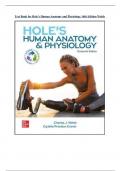
-
Test Bank for Hole’s Human Anatomy and Physiology 16th Edition Welsh
- Exam (elaborations) • 66 pages • 2023
-
- $7.89
- 2x sold
- + learn more
1) Which of the following are signs of aging at the cellular level? (Check all that apply) A) Graying hair, waning strength, and wrinkles. B) Unrepaired DNA and abnormal proteins. C) Impaired cell division and the ability to break down and recycle worn cell parts. D) A fatty liver and clogged blood vessels. Question Details Bloom's : 3. Apply Learning Outcome : 01.07.01 Identify changes related to aging, from the microscopic to the whole-body Section : 01.07 Life...
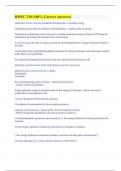
-
BMSC 230 (100% Correct Answers)
- Exam (elaborations) • 23 pages • 2023
-
- $11.49
- 1x sold
- + learn more
catabolism correct answers breakdown biomolecules to produce energy anabolism correct answers synthesis of biomolecules , requires input of energy Functions of metabolism correct answers 1) to obtain chemical energy in form of ATP from the degradation of energy-rich nutrients from environment 2) convert molecules that we ingest as food into the building blocls of larger molecules neded in the body 3) assembles these small building block molecules into larger molecules such as protie...
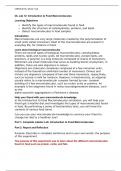
-
CHEM120 OL, Week 7 Lab Introduction to Food Macromolecules
- Other • 3 pages • 2024
-
- $18.49
- + learn more
OL Lab 12: Introduction to Food Macromolecules Learning Objectives Identify the types of macromolecules found in food Identify the structure of carbohydrates, proteins, and lipids Detect macromolecules in food samples Introduction Macromolecules are very large molecules created by the polymerization of small units called monomers. Most of the macromolecules are present in everyday life, for instance in food. Learn about biological macromolecules There are several types of b...
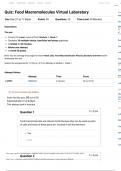
-
Ethc 210 Quiz: Food Macromolecules Virtual Laboratory
- Other • 4 pages • 2023
-
- $15.49
- + learn more
Ethc 210 Quiz: Food Macromolecules Virtual Laboratory/Ethc 210 Quiz: Food Macromolecules Virtual LaboratoryEthc 210 Quiz: Food Macromolecules Virtual LaboratoryEthc 210 Quiz: Food Macromolecules Virtual LaboratoryEthc 210 Quiz: Food Macromolecules Virtual LaboratoryEthc 210 Quiz: Food Macromolecules Virtual LaboratoryEthc 210 Quiz: Food Macromolecules Virtual LaboratoryEthc 210 Quiz: Food Macromolecules Virtual LaboratoryEthc 210 Quiz: Food Macromolecules Virtual LaboratoryEthc 210 Quiz: Food Ma...
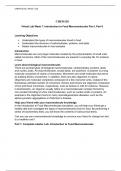
-
CHEM 120 Week 7 Virtual Lab; Introduction to Food Macromolecules Part I, Part II
- Other • 3 pages • 2023
- Available in package deal
-
- $20.99
- + learn more
Learning Objectives • Understand the types of macromolecules found in food • Understand the structure of carbohydrates, proteins, and lipids • Detect macromolecules in food samples Introduction Macromolecules are very large molecules created by the polymerization of small units called monomers. Most of the macromolecules are present in everyday life, for instance in food.
CHEM 120 Week 7 Virtual Lab; Introduction to Food Macromolecules Part I, Part II.docx
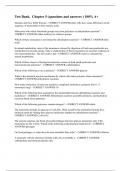
-
Test Bank, Chapter 5 (questions and answers ) 100% A+
- Exam (elaborations) • 8 pages • 2024
- Available in package deal
-
- $9.49
- 1x sold
- + learn more
Humans and mice differ because - CORRECT ANSWER-their cells have some differences in the sequence of nucleotides in their nucleic acids. Molecules with which functional groups may form polymers via dehydration reactions? - CORRECT ANSWER-either hydroxyl or carboxyl groups Which of these molecules is not formed by dehydration reactions? - CORRECT ANSWER-fatty acids In animal metabolism, most of the monomers released by digestion of food macromolecules are metabolized to provide energy. O...
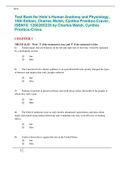
-
Test Bank for Hole’s Human Anatomy and Physiology, 16th Edition, Charles Welsh, Cynthia Prentice-Craver, ISBN10: 1260265226 by Charles Welsh, Cynthia Prentice-Crave.
- Exam (elaborations) • 692 pages • 2022
-
- $17.99
- 11x sold
- + learn more
Test Bank for Hole’s Human Anatomy and Physiology, 16th Edition, Charles Welsh, Cynthia Prentice-Craver, ISBN10: 6 by Charles Welsh, Cynthia Prentice-Crave. CHAPTER 1 TRUE/FALSE - Write 'T' if the statement is true and 'F' if the statement is false. 1) Paired organs that are bilateral, on the left and right side of the body, would be separated by a midsagittal section. ⊚ true ⊚ false 2) The transition from a hunter-gatherer to an agricultural lifestyle greatly changed the t...
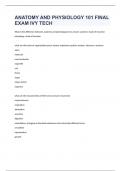
-
ANATOMY AND PHYSIOLOGY 101 FINAL EXAM IVY TECH|2023 LATEST UPDATE|GUARANTEED SUCCESS
- Exam (elaborations) • 19 pages • 2023 Popular
- Available in package deal
-
- $12.99
- 1x sold
- + learn more
What is the difference between anatomy and physiology anatomy- study of structure physiology- study of function what are the levels of organization subatomic particle- protons, electrons, neutrons atom molecule macromolecule organelle cell tissue organ organ system organism what are the characteristics of life? movement responsiveness respiration absorption secretion digestion assimilation- changing of absorbed substances into chemically different forms circulat...

-
Exploring Food Macromolecules: A Week 7 Lab Experience in CHEM120 OL
- Other • 4 pages • 2024
-
- $7.99
- + learn more
Details about a week 7 lab experiment in chem120 ol, focusing on the identification of macromolecules in food. Students will learn about the types of macromolecules (carbohydrates, proteins, and lipids), their structures, and how to detect them in food samples. The lab includes completing the simulation, recording observations, answering questions, and writing a reflection.
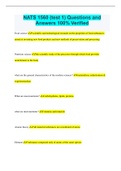
-
NATS 1560 (test 1) Questions and Answers 100% Verified
- Exam (elaborations) • 10 pages • 2023
- Available in package deal
-
- $9.99
- 1x sold
- + learn more
NATS 1560 (test 1) Questions and Answers 100% Verified Food science •scientific and technological research on the properties of food substances, aimed at inventing new food products and new methods of preservation and processing Nutrition science the scientific study of the processes through which food provides nourishment to the body what are the general characteristics of the modern sciences? materialism, reductionism & experimentalism What are macronutrients? carbohydrates, lipids, prote...

$6.50 for your textbook summary multiplied by 100 fellow students... Do the math: that's a lot of money! Don't be a thief of your own wallet and start uploading yours now. Discover all about earning on Stuvia



